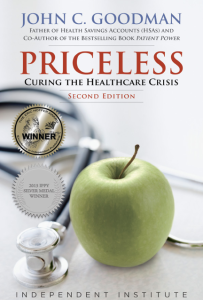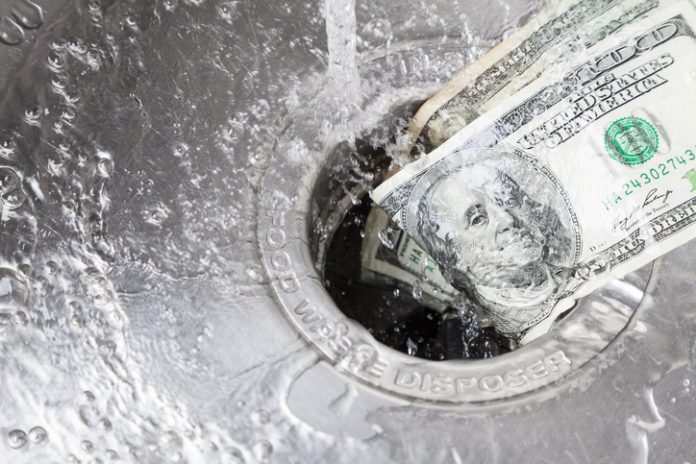Priceless – Curing the Healthcare Crisis (Updated Second Edition), by John C. Goodman, Independent Institute, 392 pages, ISBN-13: 978-1-59-813395-0, $28.95, amazon.com (Hardcover)
John C. Goodman, co-publisher of Health Care News, known as the “father of health savings accounts,” is releasing a second edition of his 2012 groundbreaking book, Priceless – Curing the Healthcare Crisis. Goodman sat down with Kenneth Artz of Health Care News to discuss why the new version was necessary.
Health Care News: What’s in the new edition?
Goodman: The first edition of Priceless was published on the eve of the rollout of Obamacare. So, that edition focused a lot on what to expect from Obamacare. In the decade that has passed, a lot of things that were in the original legislation were rescinded, so it turned out to be much less harmful than it could have been. The new edition focuses a lot more on what is wrong with the market as a whole and gives somewhat less attention to Obamacare than in the first edition.
Health Care News: What is the most important thing that came from the first edition of Priceless?
Goodman: This book is different than any other book you will find in health economics. What all the other books on health economics do is try to force health care into the supply and demand models you see in microeconomics, and it just doesn’t fit.
The title, Priceless, is a double entendre: your health is priceless, but also the health care you get has no real price. So, normal supply and demand diagrams cannot explain why you pay $100 for an aspirin tablet at a hospital.
Health Care News: How did Obamacare affect the supply side of the market for health care?
Goodman: Although the individual mandate in Obamacare was repealed, there is still a mandate on the supply side of the market, in the sense that if insurers want to sell in the individual market, they can only sell Obamacare-compliant plans. They can’t sell any other kinds of plans. The only thing you can buy, with some minor exceptions, is Obamacare insurance.

Health Care News: How do Obamacare Exchange plans compare with insurance plans in the private market?
Goodman: The most obvious comparison is with the short-term market, which offers insurance that looks pretty much like insurance did before Obamacare. Short-term, as the name implies, is there to meet short-term needs like going from home to college, college to work, or job to job, and it’s been there forever. Terms are typically up to 12 months. Obama restricted it to three months by an executive order. Trump said you can have it for a year and can renew for two more years. Now, Biden came back this spring and said, “No, you can only have these plans for three months with a one-month renewal.”
This is the most obvious alternative to Obamacare. I think three million people have this right now because of Trump’s liberalization of the rules. The premiums are half what they are in the Obamacare market, the networks are usually better, deductibles are smaller, and out-of-pocket exposure is less.
Health Care News: What happened between the first edition and second edition of Priceless?
Goodman: Trump wanted to open up alternatives to Obamacare, giving people choice, with plans that had lower premiums, broader networks, and less out-of-pocket exposure. Biden reversed this by closing off opportunities and forcing everyone into the Obamacare exchanges.
Health Care News: What are the best ideas in the new edition of Priceless?
Goodman: This is probably the only book where you’re going to discover that when we created Medicare, Medicaid, and Obamacare, we spent billions of new dollars with no increase in health care. That is a rather remarkable fact. Under Obamacare, we insured a whole bunch of new people and the average number of doctor visits per capita went down, from the time they passed the law up until the pandemic.
Another fact: we have made Obamacare virtually free for most people. If you have an average income, you’re probably not paying any premium at all when you go into the Exchange. So, one reason the insurance numbers look so good, why there are a lot more people with insurance, is because they’re giving it away. That’s great if you’re healthy, but if you get sick, the out-of-pocket exposure is really higher than anywhere else in our health care system. It can be $9,400 for an individual and almost $19,000 for a family.
What was the main argument for Obamacare? It wasn’t that we wanted to do something for people who are healthy; it was that we wanted to do something for people with pre-existing conditions. What we now have is a system that’s really good for healthy people and really bad if you’re sick.
Going back to my book, Patient Power, I have always argued that we should all get the same tax credits and have a free market for health insurance. That was adopted by John McCain in his presidential campaign. There have been several bills to do that introduced in Congress, one by Paul Ryan, and most recently by Pete Sessions.
Health Care News: What will a layperson get from reading Priceless?
Goodman: We would like to believe that our system is really different from Canada’s—Bernie Sanders said it was really different; but, in fact, they’re 80 percent the same because in both countries we’re paying with time, and not with money. We need a price system, a free market for health insurance, doctor care, and hospital care.





















